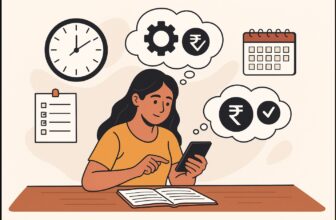In India, social media has grown from being a casual pastime to a daily routine that shapes how people spend their mornings, evenings, and even mealtimes. With over 750 million internet users and growing, platforms like WhatsApp, Instagram, Facebook, YouTube, and homegrown apps such as Moj and ShareChat dominate daily attention spans. While these platforms help you stay connected, entertained, and informed, they also encourage habits that can quietly consume hours each day.
What begins as a quick glance at a notification often turns into long scrolling sessions, leaving you with less time for studies, work, family, or rest. This constant pull can feel overwhelming, but the good news is that you don’t need to quit social media completely to find balance. Small, practical steps, like limiting app time, creating phone-free zones, or cultivating offline hobbies, can help you enjoy the benefits of staying connected without letting social media control your life.
The following strategies highlight simple yet effective ways to cut back on excessive use and rebuild healthier digital habits, especially within the fast-paced, always-online environment of modern India.
12 Signs You’re Addicted to Social Media
1. Checking Notifications First Thing in the Morning
If you reach for your phone even before brushing your teeth or greeting family members, it’s a strong signal of dependency. Many Indians wake up and immediately check WhatsApp groups, missed calls, and Instagram updates, making mornings more stressful than peaceful.
2. Phantom Vibration Syndrome
Do you often feel your phone buzzing even when it hasn’t? This is common among heavy users in India, where carrying two phones (work and personal) amplifies the feeling. It shows how deeply the brain is wired to expect constant alerts.
3. Constantly Refreshing Feeds
Pulling down to refresh Instagram or Twitter/X to see the latest Reels or posts is a compulsive pattern. For students waiting for exam results or employees stuck in long office hours, refreshing feeds becomes a reflex, not a choice.
4. Losing Track of Time
You may open YouTube for a 10-minute break and end up spending 2 hours watching Shorts. Many students in India report losing study hours during board exams because “just one reel” turned into 50.
5. Anxiety When Offline
If power cuts or poor data connectivity in India frustrate you more than anything else, it’s a sign of social media dependence. Feeling restless when your phone battery is low or when there’s no Wi-Fi shows emotional reliance.
6. Comparing Life with Others
Scrolling through holiday pictures from Goa, Ladakh, or international trips can trigger FOMO. Even seeing friends buying the latest iPhone or bike on EMI can make you feel your life is “less exciting.”
7. Prioritizing Online Likes Over Real Conversations
When happiness depends on the number of likes on an Instagram post or YouTube views rather than a face-to-face compliment, social validation replaces real connection. This is increasingly common among urban youth in India.
8. Neglecting Studies or Work Tasks
Students delaying assignments or office employees sneaking peeks at Reels during work meetings is a widespread problem. Social media cuts into productive hours, leading to guilt and stress.
9. Sleep Disruption
Scrolling late at night under a blanket is now routine in many Indian homes. Blue light exposure delays sleep, reducing productivity the next day. College students often sacrifice sleep before exams to binge-watch Reels or memes.
10. Using Social Media While Eating or Driving
Checking Reels at dining tables or scrolling at traffic lights is becoming normalized. Apart from safety concerns, it reduces family bonding during meals, a cultural tradition in India.
11. Reduced Patience for Non-Digital Activities
Books, long conversations, or even hobbies like gardening feel “boring” compared to the constant dopamine hits from scrolling. Indian youth increasingly abandon outdoor sports for mobile games and social media engagement.
12. Emotional Dependence
Mood swings caused by online comments or lack of likes are strong addiction markers. A negative reply in a WhatsApp group or fewer likes than expected on a post can ruin the day, showing how emotions get tied to virtual approval.
13 Ways to Step Back and Regain Balance
1. Set App Time Limits
Both Android and iOS smartphones come with built-in features to help you manage screen time. On Android, Digital Wellbeing lets you set daily usage limits for apps like Instagram, Facebook, or YouTube. On iPhones, Screen Time offers similar controls. For example, you can set Instagram to close automatically after 30 minutes of daily use. This not only keeps scrolling in check but also makes you more conscious of how much time you spend online. Many Indian parents are now using these tools to monitor children’s screen time, especially during exam season.
2. Turn Off Non-Essential Notifications
Notifications are designed to pull you back into apps. Constant pings from WhatsApp family groups or Instagram likes can make you feel compelled to check your phone every few minutes. The solution is simple, disable non-essential notifications. Keep only urgent alerts, like calls or work-related emails, and mute everything else. Indians often complain about “Good Morning” spam messages on WhatsApp groups, muting those groups is an easy way to reduce distractions.
3. Schedule “No-Phone Zones”
Designate spaces and times in your home where phones aren’t allowed. Common no-phone zones include dining tables, bedrooms, and family gathering areas. For instance, many Indian families are now following a “no gadgets at dinner” rule to encourage real conversations. Keeping phones out of bedrooms also helps you sleep better, since late-night scrolling is one of the biggest reasons for poor rest.
4. Replace Scroll Time with Reading or Podcasts
Scrolling often fills idle time, but you can replace that with meaningful alternatives. Reading e-books in your mother tongue (Hindi, Tamil, Bengali, or others) not only reduces screen addiction but also preserves regional literature. Similarly, listening to Indian podcasts, on topics ranging from cricket to history to spirituality, can turn unproductive scrolling into engaging learning. Apps like Audible, Storytel, and Spotify have large collections of Indian content.
5. Try the “30-Minute Delay” Rule
The first half hour after waking up sets the tone for your entire day. Instead of checking WhatsApp statuses or Instagram Reels immediately, delay opening these apps by at least 30 minutes. Use that time for yoga, meditation, a short walk, or simply enjoying chai with family. Many Indians who adopted this practice report feeling less stressed in the morning and more focused during the day.
6. Unfollow & Unsubscribe Strategically
FOMO (Fear of Missing Out) is a major driver of social media addiction. Seeing friends vacationing in Goa or posting about buying the latest iPhone can create unnecessary pressure. To avoid this, unfollow accounts that make you feel anxious or inadequate. Replace them with creators who provide educational or motivational content, coding tutorials, cooking channels, or wellness blogs. This way, your feed becomes a source of growth instead of comparison.
7. Use Greyscale Mode
Colors are powerful stimulants, bright reds and blues in apps like Instagram and YouTube are intentionally designed to grab your attention. Switching your phone to greyscale mode makes everything look duller, which reduces the urge to scroll. This method is gaining popularity among Indian students preparing for competitive exams like UPSC or JEE, since it helps them avoid distractions without uninstalling apps.
8. Allocate a “Digital Detox Day”
Dedicate one day a week, or at least one Sunday a month, to staying offline. Families in India are rediscovering simple joys on these days, such as visiting relatives, cooking together, or playing board games like Ludo and Carrom. Even a short break from screens allows your brain to reset and reduces dependence on constant digital stimulation.
9. Practice Mindful Social Media Use
Before opening an app, ask yourself a simple question: Why am I logging in? If the reason is to check updates or share something meaningful, proceed. If it’s boredom or habit, consider doing something else instead. This mindful check-in reduces aimless scrolling. For example, instead of opening YouTube to “just browse,” you could decide in advance to watch a tutorial on Indian cooking or a lecture on personal finance.
10. Invest in Offline Hobbies
Offline hobbies provide a natural balance to digital life. In Indian cities, weekend hobby clubs for cricket, badminton, yoga, and painting are becoming popular. Gardening, learning a musical instrument, or joining a dance class can replace endless online time with fulfilling real-life skills. For children especially, hobbies offer healthier ways to spend evenings instead of being glued to screens.
11. Replace Chat Apps with Face-to-Face Meetings
Instead of chatting endlessly on WhatsApp, try meeting friends in person. Catch up over chai at a local tapri, visit a park, or take an evening walk. Offline conversations often feel deeper and more refreshing compared to endless typing. Many young professionals in India are now using weekends to reconnect with college friends offline instead of continuing the loop of group chats.
12. Track Usage Progress Weekly
Awareness is the first step to change. Most smartphones provide weekly screen time reports. Many Indians are shocked to see they spend 4-5 hours daily on Instagram, YouTube, or Facebook. Tracking this data helps you set realistic reduction goals, for example, reducing usage by 30 minutes each week. Apps like Digital Detox and minimalist phone launchers can also help you stay accountable.
13. Seek Professional Guidance if Needed
If social media addiction affects your work, relationships, or mental health, it’s important to seek help. India now has multiple affordable platforms for online counseling, such as YourDOST, BetterLYF, and therapy sessions available through Practo. These services connect you with trained psychologists who can provide guidance and coping strategies. Counseling is especially valuable for students and young professionals who find it difficult to cut back on their own.
Balancing India’s Digital Growth with Real-Life Connection
India’s shift toward a digital-first lifestyle is undeniable. From e-learning platforms that reach students in remote towns, to the rise of UPI payments in daily shopping, and the explosion of short-video entertainment apps, online life is woven into almost every aspect of modern living. This rapid growth brings convenience and opportunity, but it also raises the risk of losing touch with offline relationships and routines.
Recognizing this, different parts of Indian society are slowly adapting. Schools are launching programs to educate children about healthy screen habits, offices are encouraging regular breaks from devices to protect employee well-being, and families are making conscious efforts to revive traditional practices such as shared meals, evening walks, or community gatherings. These steps reflect the need to use digital tools as support systems rather than as substitutes for real human connection.
Ultimately, social media and online platforms should serve as enablers, helping you learn, connect, and explore opportunities, but they cannot replace the value of face-to-face conversations, cultural traditions, and personal time. A balanced approach ensures that India’s digital progress strengthens, rather than weakens, the human connections at its core.
Summary – Social Media Addiction in India
Social media is not inherently negative, it becomes problematic only when it starts dictating how you spend your time and energy. The key lies in awareness: once you recognize the signs of overuse, you can take conscious steps to bring balance back into your life. Simple changes, such as setting boundaries or creating offline routines, gradually shift control from the apps back to you.
The aim is not to abandon social media altogether, but to use it with intention. When managed well, these platforms can help you stay informed, connected, and even inspired. The challenge is to prevent them from disrupting your sleep, focus, or relationships. By making mindful choices, you ensure that social media remains a helpful companion.





